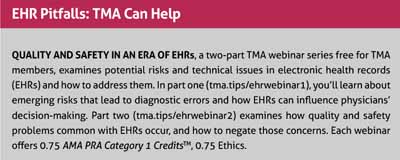
For too long, says Dallas orthopedic surgeon David Brigati, MD, measures of a physician’s quality of care have been about process: the average length of a patient stay, for example, or a patient’s readmission rate.
The bottom line is results, and that’s why Dr. Brigati believes a shift to patient-reported outcome (PRO) measures is necessary.
PRO measures derive from patients’ evaluation of their post-treatment health status: for instance, their ability to move after knee surgery, or their symptoms and quality of life while undergoing chemotherapy or diabetes treatment. They aren't new; out of the Medicare Quality Payment Program’s (QPP’s) 219 total quality measures for 2020, 18 are designated as PRO measures.
But Dr. Brigati wants to see them become more widely used.
“You’re trying to optimize something,” he said. “For blood pressure, it’s trying to get [patients’] numbers down. For joint replacement, it’s trying to get their quality of life up and their joint-specific function up. What is the most validated way that we can do that? With a patient-reported outcome.”
However, even proponents of PRO measures note that collecting the information from patients for those metrics places burdens on physicians, and some remain skeptical of bonuses and penalties tied to a measure that derives from a subjective factor: what patients think.
Product over process
Patient-reported outcome measures aren’t as simple as an unscientific patient satisfaction score. Here’s an example of how they work:
Orthopedists who perform a knee-replacement surgery, for instance, collect patient feedback using the validated Knee Injury and Osteoarthritis Outcome Score for Joint Replacement questionnaire developed by the Hospital for Special Surgery. The survey allows patients to rate the amount of knee pain they’ve experienced in the past week going up or down stairs, for example, with options ranging from “none” to “extreme.” The patient’s score from those questions gets converted to a 100-point scale, where 0 means the patient has total knee disability and 100 means the knee is completely healthy.
Organizations like Minnesota-based MN Community Measurement (MNCM) – which develops both clinical and PRO measures, including for QPP – then use the patient feedback from the questionnaire and other tools to create a patient-reported outcome measure for knee function. MNCM also has created PRO measures for depression and asthma symptom control, among others.
The organization takes “a validated tool that has gone through rigorous testing” and uses it to create its patient-reported outcome measures, said Collette Cole, clinical measure developer for MNCM. “We go through a development process with a team of experts, and we’re selecting those tools that we’re basing the [PRO] measures on, based on criteria, before we determine what those measures will be and how the measure will be constructed.”
Dr. Brigati, who’s part of Privia Medical Group of North Texas, says although PRO quality metrics aren’t perfect, they’re “absolutely an order of magnitude better than what we are doing now” with process-focused metrics that dominate most quality programs.
“If you focus only on process measures and not the outcome, what you’re tending to be focusing on is, what was the cost to produce the product that you ended up with – whether that product is good, bad, or indifferent – versus what you should be focusing on: What is the product you achieved? What was the outcome you got to?” Dr. Brigati said. “Then you can think about, what was the cost it took to achieve it?”
Austin orthopedic surgeon Kevin Bozic, MD’s use of patient-reported outcomes has evolved over time. While he’s used PROs since he began practicing in the early 2000s, in the past seven to eight years he’s switched from using the outcomes as a research and performance improvement tool to a clinical decisionmaking tool.
“What’s different now is we use them in shared decisionmaking with individual patients to determine what treatment is most appropriate for them,” said Dr. Bozic, chair of surgery and perioperative care at The University of Texas at Austin Dell Medical School. “So that we know that at baseline, [if] a patient comes in at a certain level of pain and functional disability, which treatments are likely to benefit them the most.”
Drawbacks
In QPP, outcome measures, such as PRO metrics, are part of a physician’s score in the Quality performance category, which accounted for 45% of the scoring in 2020, and will be 40% of 2021 scores. In 2020, participants were required to pick at least six measures to report, one of which had to be an outcomes measure.
Despite his support for a transition to more widespread use of PRO measures, Dr. Brigati understands why many physicians dislike them.
For one thing, the measures are “still pretty premature in terms of how they’re tied to payment,” he said, adding that insurers use PROs as a check-the-box measure. Plus, “Most of the physicians are not really positive about anything that is going to be used to compare [doctors] to other people. Because the concern is always, is it fair? So there’s been a lot of resistance from physicians in terms of startup costs. There’s been a lot of resistance from physicians in terms of understanding it – because it takes a lot of time to understand. If you’re going to use the tool … you’ve got to understand how to interpret it. You’ve got to understand what the population norms are: ‘Does that number mean my patient’s doing well, or not well?’”
Houston oncologist Ron Walters, MD, a member of TMA’s Council on Health Care Quality, says another source of physician apprehension is properly attributing PROs, and it’s a valid one.
“It depends what kind of physician you are. Because surgeons … have a very 1-to-1 relationship with the patient and their outcomes,” Dr. Walters said. But with other types of care, involving internists or medical oncologists who rotate taking calls, for example, “the patient believes there’s one person in charge of their entire care, but actually there are many people involved in care. And all of those can affect the attribution side of things. … When it’s tied to payment, of course that becomes an issue right away.”
Dr. Brigati adds PROs also are irritating in terms of the paperwork and bureaucracy they introduce. Physicians have a choice whether to capture patient feedback electronically or on paper, and both options “have their ups, downs, startup costs, and annoyances.” And integrating PRO collection into the daily workflow is challenging.
For example, even if a medical assistant collects and scores the patient’s feedback, the physician still must interpret the data. “And then ideally, you have to spend some time with the patient explaining why you had them fill it out and what it means,” Dr. Brigati added. “It’s onerous. It’s a difficult process to implement.”
One of his colleagues at Privia, Fort Worth family physician James Harvey, MD, adds that there are specialists who are simply wary of value-based care.
“Truthfully, specialists have been in a fee-for-service world forever, and we’re asking them to fundamentally change the way they get paid for what they do. That’s pretty terrifying,” said Dr. Harvey, who believes PRO measures are essential for value-based care. “Their fear of the whole value-based process and changing how they get paid, gets rolled up into this concern about patient-reported outcomes.”

Improving care
Texas Medical Association policy does not address patient-reported outcomes, but it does adopt the American Medical Association’s principles for pay-for-performance programs: ensuring quality of care; fostering the patient-physician relationship; offering voluntary physician participation; using accurate data and fair reporting; and providing fair and equitable incentives.
To physicians worried about quality measures determining their payments, Ms. Cole of MNCM stresses the rigorous validation process involved. She says MNCM strives to create measures that are patient-centric and look for a desired outcome, with an understanding that not every patient will reach it. The measures are risk-adjusted, she said, but standard risk adjustments for outcome measures, such as socioeconomic status, tend to apply to patients’ pre-operative status.
“There are some providers, and some measures, where the thought is, ‘Everybody should be 100%, and if I can’t be 100%, then don’t include that measure in that program.’ Oftentimes, there are check-the-box measures, and they really don’t drive health outcomes forward,” Ms. Cole said. “There’s a place and a time for those kind of measures when maybe a process isn’t in place, maybe it’s something new, maybe something isn’t working well. But over time, those processes are put in place, and there’s not really a reason to measure them anymore.”
Dr. Brigati says process measures still have their place in quality reporting, but don’t get to the heart of what medicine should be about.
“It should be more about what kind of outcomes are you producing, and it should be fun for you. It’s honestly a fun challenge to look at scores and say, ‘Well, I think that I made that patient’s life better,’ and really feel that their life’s getting better, and you’re going to choose the outcome measure that’s going to help you understand that in the most scientifically rigorous way,” he said.
Tex Med. 2020;117(1):34-37
January 2021
Texas Medicine ContentsTexas Medicine Main Page